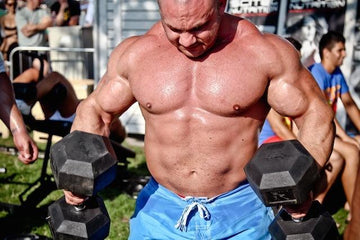

Spread the Protein for Greater Muscle Mass and Weight Loss
Table of Contents
Spread the Protein for Greater Muscle Mass and Weight Loss
by: Robbie Durand
If you lose weight too fast, you lose more muscle than when you shed excess pounds more slowly, a small study says.
The fear of losing muscle is a common phenomenon among dieting bodybuilders, fitness models and recreational lifters. Everybody is afraid that a few hours without protein or some form of amino acids in your system can cause initiation of catabolic processes a.k.a. muscle loss. If you lose weight too fast, you lose more muscle than when you shed excess pounds more slowly, a small study says.
In a previous study, researchers put 25 participants on a five-week very-low-calorie diet of just 500 calories per day. Another 22 volunteers went on a 12-week low-calorie diet of 1,250 calories per day. The investigators found that at the end of the study, both groups had similar levels of weight loss (i.e. 19 pounds for both groups) . The researchers then looked at the loss of fat-free mass, which includes all the tissue in the human body, except fat. The major tissues are blood, bones, organs and muscles. However, the mass of the organs, blood and bones does not change during dieting. Therefore, changes in fat-free mass during dieting are mainly due to changes in muscle mass. Participants on the very-low-calorie diet had lost about 3.5 pounds of fat-free mass, compared with 1.3 pounds among those on the low-calorie diet. Fat-free mass accounted for 18 percent of weight loss in the very-low-calorie diet group and 7.7 percent of weight loss in the low-calorie diet group, the study found. Four weeks after the end of their diets, reductions in fat-free mass averaged 1.8 pounds among those in the very-low-calorie diet group and 0.7 pounds among those in the low-calorie diet group. Fat-free mass accounted for 9.4 percent of weight loss in the very-low-calorie diet group and 2.9 percent of weight loss in the low-calorie diet group, according to the report. In sum, the loss of fat-free mass was higher after rapid weight loss diet than slow diet-induced weight loss with similar total weight loss. So losing muscle mass is something to do concerned about while dieting, but a way to prevent muscle mass loss is with resistance exercise training and also keeping protein intake high.

| A new study in the American Journal of Physiology: Endocrinology and Metabolism points out the importance of maintaining high protein diet in conjunction with a resistance exercise protocol is to the dieter. Researchers had 20 obese males, aged randomly allocated to either a balanced meal profile (4 meals per day with 25% of daily protein intake per meal) or a skewed meal profile (4 meals per day with protein allocated at ~7% at breakfast, ~17% at lunch, ~72% at dinner, ~4% pre-bed)). In SKEW, the protein content of breakfast, lunch and the pre-bed snack was < 20g (< 0.22 g/kg) and dinner provided 70 – 110 g (~0.94 g/kg), depending on each participant’s daily protein requirement. In both groups, meals contained a variety of plant- and animal-based protein sources, but only in balanced group a ready-to-drink whey protein micelle (WPM) beverage was consumed as part of breakfast and the pre-bed snack as a practical means of achieving target protein intakes at these meals which are typically low in protein. |
 So to summarize, the only significant difference between the only difference between the two study groups you see in the illustration of the study design below is the use of a whey protein supplement as a major source of protein (vs. whole foods). The subjects from the SKEW group who did not consume any form of protein supplement got all their protein from dietary sources. The subjects engaged in 2 weeks of energy restriction, followed by 2 weeks of energy restriction plus a program of low-load, high-volume resistance training (2 – 3 sets of 20 – 30 repetitions to muscular failure), comprising 3 workouts per week. Exercises included the chest press and seated row for the upper body and the leg press, knee extension, and leg curl for the lower body.
So to summarize, the only significant difference between the only difference between the two study groups you see in the illustration of the study design below is the use of a whey protein supplement as a major source of protein (vs. whole foods). The subjects from the SKEW group who did not consume any form of protein supplement got all their protein from dietary sources. The subjects engaged in 2 weeks of energy restriction, followed by 2 weeks of energy restriction plus a program of low-load, high-volume resistance training (2 – 3 sets of 20 – 30 repetitions to muscular failure), comprising 3 workouts per week. Exercises included the chest press and seated row for the upper body and the leg press, knee extension, and leg curl for the lower body.
At the end of the study, muscle protein synthesis rates were ~14% lower in the two energy restriction conditions (with and without resistance training) compared to during the energy balance condition at baseline. The researchers found that muscle protein synthesis rates were ~19% higher in the balanced condition than in the skewed condition (i.e. The group that consumed 25% protein with each meal). Another interesting finding was that muscle protein synthesis rates were higher in the energy restriction with resistance training condition than in the energy restriction condition without resistance training.
The researchers concluded that consuming a balanced distribution of daily protein leads to greater muscle protein synthesis than a skewed distribution of the same amount of protein, in overweight and obese elderly males. They also found that performing resistance training elevated muscle protein synthesis rates during a period of caloric restriction. The key points of the study were that protein intake needs to be kept high and taken regularly and taken in conjunction with a resistance training program to working optimally.
Murphy C.H, Churchward-Venne T.A, Mitchell C.J, Kolar N.M., Kassis A., Karagounis L.G., Burke L.M., Hawley J.A. and Phillips S.M., Hypoenergetic diet-induced reductions in myofibrillar protein synthesis are restored with resistance training and balanced daily protein ingestion in older men. American Journal of Physiology 2015.

















